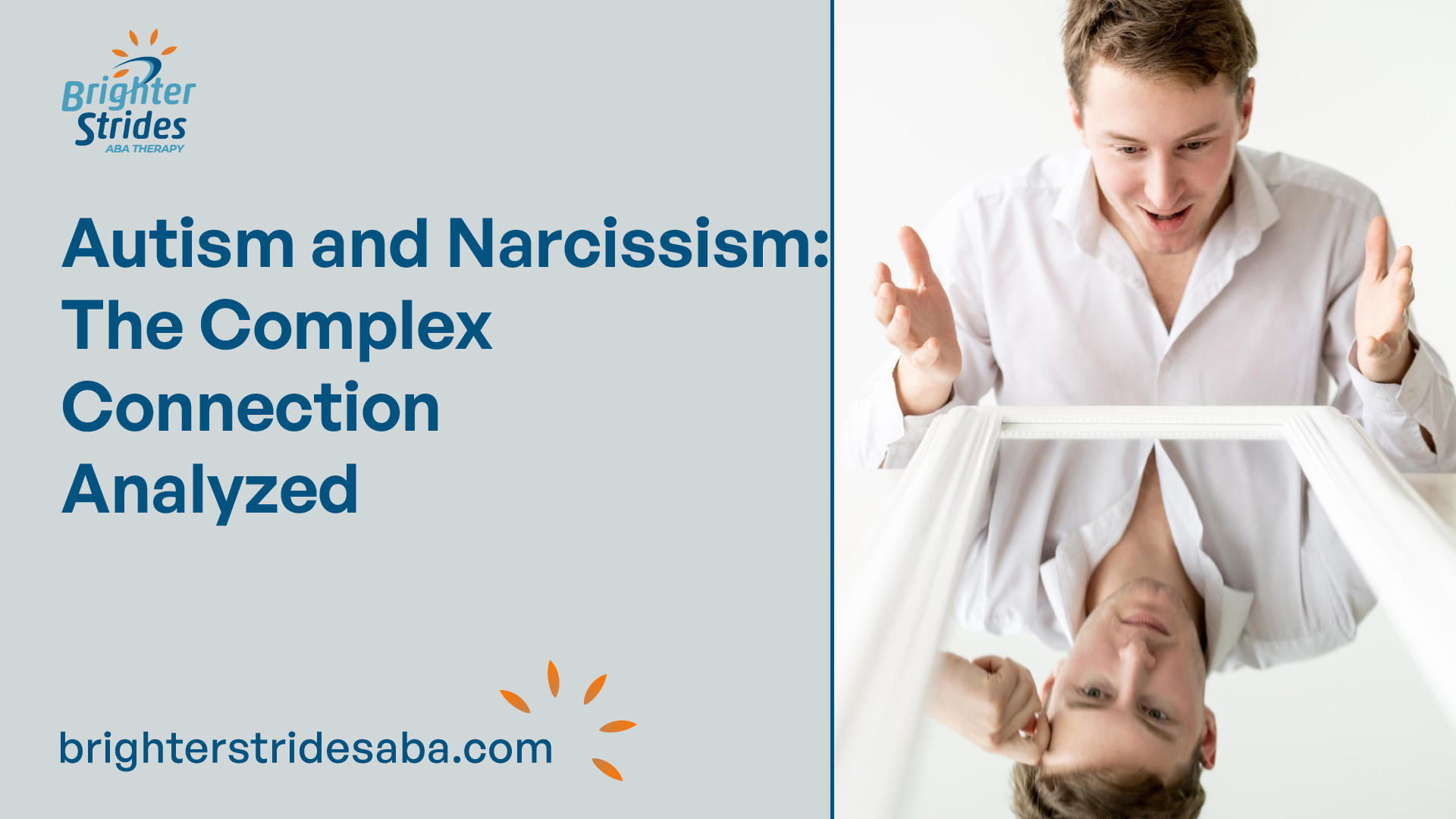Understanding Autism and Narcissism
To comprehend the complex connection between autism and narcissism, it is essential to have a clear understanding of each individual condition. Autism Spectrum Disorder (ASD) and Narcissistic Personality Disorder (NPD) are two distinct psychological conditions that can have overlapping characteristics but are fundamentally different from one another.
Autism Spectrum Disorder (ASD)
Autism Spectrum Disorder (ASD) is a neurodevelopmental disorder that affects social interaction, communication, and behavior. It is characterized by a wide range of symptoms and can vary in severity and presentation, leading to the concept of a spectrum disorder.

Individuals with ASD may experience challenges in social communication and interaction. They may have difficulty understanding social cues, making eye contact, and engaging in reciprocal conversation. Additionally, they may exhibit repetitive behaviors and demonstrate a strong attachment to routine. It’s important to note that autism is a complex condition influenced by a combination of genetic and environmental factors, and while there may be genetic predispositions, they do not determine the development of autism.
Narcissistic Personality Disorder (NPD)
Narcissistic Personality Disorder (NPD) is a personality disorder characterized by an inflated sense of self-importance, a lack of empathy, and a constant need for admiration. Individuals with NPD often have an exaggerated sense of their own abilities and achievements. They may belittle or exploit others to maintain their sense of superiority. Moreover, they may exhibit a grandiose sense of entitlement and a disregard for the feelings and needs of others.
While there may be some overlapping traits between individuals with autism and narcissism, it is important to recognize that the underlying mechanisms and motivations behind these conditions are distinct. Autism primarily affects social interaction, communication, and behavior, while narcissism is characterized by personality traits centered around self-centeredness and a lack of empathy.
By understanding the unique nature of autism and narcissism, we can better appreciate the complexities of these conditions and how they impact individuals’ lives. It is essential to approach each condition with empathy, respect, and an open mind, avoiding generalizations and stereotypes in order to foster understanding and support for those affected.

Characteristics of Autism and Narcissism
To better understand the complex connection between autism and narcissism, it is important to examine the characteristics associated with each condition separately.
Autism Traits
Autism, also known as Autism Spectrum Disorder (ASD), primarily affects social interaction, communication, and behavior. Individuals with autism may exhibit a range of characteristics that can vary in severity from person to person. Some common traits of autism include:
- Difficulty understanding social cues and nonverbal communication
- Challenges with making and maintaining eye contact
- Difficulty engaging in reciprocal conversation
- Preference for routine and resistance to change
- Repetitive behaviors or restricted interests
It is important to note that these traits are not indicative of narcissism itself, but rather reflect the unique characteristics of autism.
Narcissistic Traits
Narcissistic Personality Disorder (NPD) is characterized by a pattern of self-centeredness, self-enhancement, and a lack of empathy. Individuals with narcissism may exhibit the following traits:
- A belief in their own superiority and entitlement
- Manipulation of others’ feelings to control or dominate them
- Arrogance and a sense of grandiosity
- Difficulty handling criticism or rejection
- Lack of empathy and disregard for the feelings and needs of others
It is crucial to differentiate between autism and narcissism, as the underlying reasons for the behaviors associated with these conditions differ significantly. While individuals with autism may exhibit behaviors that overlap with narcissistic traits, it is important not to confuse these behaviors with true narcissistic personality traits. Proper evaluation and care should be provided with an understanding of the unique characteristics of autism.
Understanding the distinct characteristics of autism and narcissism is essential in order to provide appropriate support and interventions for individuals who may exhibit behaviors associated with these conditions.
Overlapping Behaviors
When examining the connection between autism and narcissism, it is important to note that individuals with autism spectrum disorder (ASD) may display behaviors that overlap with narcissistic traits, such as challenges in empathy and social interaction difficulties. However, it is crucial to consider the underlying reasons for these behaviors, which differ between autism and narcissism, when evaluating and providing care for individuals with these conditions.
Challenges in Empathy
Both individuals with ASD and those with narcissistic personality disorder (NPD) may exhibit challenges in empathy, although the underlying mechanisms and manifestations differ. Individuals with ASD may struggle to understand and share the feelings of others, making it difficult for them to connect emotionally. This can result in difficulties in recognizing and responding appropriately to the emotional states of those around them.
On the other hand, individuals with NPD may display a lack of empathy, characterized by a diminished ability to understand and connect with the emotions and experiences of others. This lack of empathy can lead to a disregard for the feelings and needs of others, as individuals with NPD prioritize their own self-interest and maintain a sense of superiority.
Social Interaction Difficulties
Both autism and narcissism can present challenges in social interactions, albeit in different ways. Individuals with autism may have difficulty understanding social cues, making eye contact, engaging in reciprocal conversation, and forming meaningful relationships. These difficulties can stem from challenges in social communication and interaction, which are core features of ASD.
In contrast, individuals with NPD may exhibit social interaction difficulties due to their self-centered and exploitative nature. They may belittle or exploit others to maintain their sense of superiority and may struggle to establish genuine connections with others.
It is important to note that while there may be overlapping behaviors in terms of empathy and social interaction difficulties, it is essential to understand and address these behaviors within the context of each condition. Autism and narcissism are distinct conditions with different underlying causes and treatment approaches. By recognizing and differentiating these conditions, appropriate support and interventions can be provided to individuals with either autism or narcissism to meet their unique needs.

Differentiating Autism and Narcissism
When examining the complex connection between autism and narcissism, it is crucial to differentiate between the two in order to provide appropriate support and interventions for individuals. Autism Spectrum Disorder (ASD) and Narcissistic Personality Disorder (NPD) have distinct characteristics that require careful consideration for accurate diagnosis and effective treatment.
Diagnostic Considerations
Autism is a neurodevelopmental disorder that affects social interaction, communication, and behavior. It is important to recognize that autism is a spectrum disorder, meaning that it can vary in severity and presentation. Individuals with autism often display behaviors such as repetitive movements, difficulties in nonverbal communication, and challenges in social interactions.
On the other hand, narcissism is a personality disorder characterized by an inflated sense of self-importance, a lack of empathy, and a constant need for admiration. Individuals with narcissistic traits are often preoccupied with their own achievements and lack genuine empathy towards others.
To differentiate between autism and narcissism, it is crucial to assess the underlying reasons behind certain behaviors. While individuals with autism may display behaviors that overlap with narcissistic traits, it is important to approach these behaviors with an understanding of the unique characteristics of autism and not confuse them with true narcissistic personality traits.
Treatment Approaches
Once a correct diagnosis has been made, treatment approaches can be tailored to address the specific needs of individuals with autism or narcissism.
For individuals with autism, intervention strategies often focus on enhancing social skills, improving communication abilities, and addressing sensory sensitivities. Applied Behavior Analysis (ABA), speech therapy, occupational therapy, and social skills training are common interventions used to support individuals with autism.
In the case of narcissism, treatment approaches may involve psychotherapy or counseling to address underlying self-esteem issues and promote empathy and healthier interpersonal relationships. Cognitive-behavioral therapy (CBT) and psychodynamic therapy are commonly utilized to support individuals with narcissistic traits.
It is essential for healthcare professionals and caregivers to work collaboratively to develop individualized treatment plans based on the specific needs and characteristics of each individual. By differentiating between autism and narcissism, appropriate interventions can be implemented to support individuals in their personal growth and development.
Understanding the distinctions between these two conditions allows for accurate diagnosis and the implementation of effective strategies to improve the lives of individuals with autism and those with narcissistic traits. By providing the right support and interventions, we can help individuals navigate their unique challenges and reach their full potential.
Supporting Individuals with Autism and Narcissism
When it comes to supporting individuals with co-occurring autism and narcissism, tailored interventions and therapeutic approaches are essential. Understanding the specific needs and challenges associated with each condition is crucial in providing effective support and interventions.
Tailored Interventions
Tailored interventions are necessary to address the unique needs of individuals with autism, narcissism, or both. While there may be overlapping behaviors and challenges in empathy and social interaction, it is important to recognize and address the distinctions between Autism Spectrum Disorder (ASD) and Narcissistic Personality Disorder (NPD) to ensure appropriate support.
By developing individualized intervention plans, professionals can focus on the specific strengths and areas of improvement for each individual. This may involve utilizing strategies such as social skills training, cognitive-behavioral therapy, and behavior analysis techniques. The goal is to address the core symptoms and challenges associated with both conditions, while also promoting the individual’s overall well-being and development.
Therapeutic Approaches
In therapeutic settings, it is crucial to recognize and address the co-occurrence of autism and narcissism to ensure effective interventions and support. While there is no proven medication or specific therapy for NPD, therapeutic approaches can still offer hope for recovery and improvement in individuals with narcissistic traits.
Establishing a trusting and supportive relationship between the individual and the therapist is a fundamental aspect of therapeutic approaches. Through regular therapy sessions, individuals with narcissistic traits can explore and gain insight into their behaviors and develop healthier coping mechanisms. Building self-awareness and empathy are key components in helping individuals with narcissism navigate their relationships and improve their overall well-being.
For individuals with autism, therapeutic approaches may include Applied Behavior Analysis (ABA), speech and language therapy, occupational therapy, and social skills training. These interventions aim to address the unique challenges individuals with autism face in communication, social interaction, and sensory processing. By providing a structured and supportive environment, individuals with autism can develop skills to enhance their daily functioning and quality of life.
By considering the specific needs of individuals with co-occurring autism and narcissism, tailored interventions and therapeutic approaches can provide the necessary support and guidance. Understanding the distinctions between these conditions and recognizing the unique challenges they present is crucial in promoting individual growth, development, and overall well-being.
Misconceptions and Awareness
In order to properly understand the complex connection between autism and narcissism, it is crucial to dispel misconceptions and promote awareness about these two distinct conditions.
Understanding the Spectrum
Autism, known as Autism Spectrum Disorder (ASD), refers to a broad range of conditions characterized by challenges with social skills, repetitive behaviors, speech, and nonverbal communication. The term “spectrum” is used to acknowledge the wide variation in symptoms and functioning levels among individuals with ASD.
It is important to recognize that autism is a lifelong condition that typically appears in children during early childhood, usually before the age of three. However, the onset of symptoms can vary, with some children showing signs from birth, while others may develop typically for a period before experiencing a regression in skills. Early intervention plays a crucial role in improving outcomes for individuals with autism.
Autism does not discriminate based on gender, as it occurs in all racial, ethnic, and socioeconomic groups. However, boys are about four times more likely to be diagnosed with autism compared to girls.
Avoiding Stereotypes
While there is no direct link between autism and narcissism, it is important to understand that individuals with autism may have difficulty understanding or expressing emotions, which can be misinterpreted as a lack of empathy similar to that seen in Narcissistic Personality Disorder (NPD). However, these conditions are distinct and should be approached and supported independently. It is crucial to avoid stereotyping individuals with autism or assuming that they possess narcissistic traits.
By promoting understanding and awareness of the autism spectrum and avoiding stereotypes, we can foster a more inclusive and supportive environment for individuals with autism. It is essential to approach each condition with appropriate knowledge and seek the necessary support and resources for individuals affected by autism and narcissism.

 We've just released an article!
Check out our blog!
We've just released an article!
Check out our blog!



